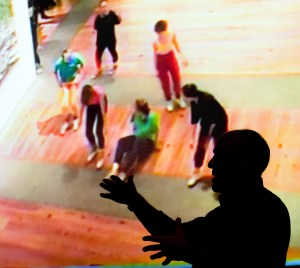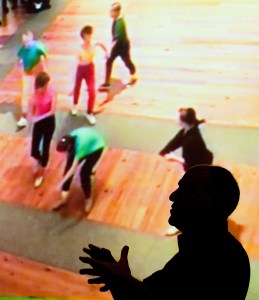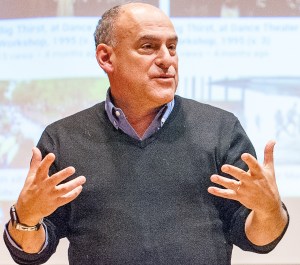LEWISTON — Choreographer Stephan Koplowitz has been spending a lot of time lately in places that most people avoid.
Since 2014, he’s paid a handful of visits, for example, to the debris-strewn expanses of Bates Mill No. 5. There, where most of us would see nothing more than dust, spiders and rusty machine parts, Koplowitz sees art.
“Every time I go there,” he told an audience at the Lewiston Public Library, “I see something new.”
What he sees in the mill and elsewhere around Lewiston-Auburn will ultimately become Koplowitz’s latest project, “Mill Town,” which will be presented by the Bates College Dance Festival this summer.
But the award-winning and internationally renowned director and choreographer didn’t agree to speak in Lewiston just to plug his work. To the delight and fascination of two dozen people, Koplowitz also shared his process.
And what a process it is. When Koplowitz visits a site — and he’s visited plenty: since 1984, he has created 87 works around the globe — he doesn’t just take inventory of what is there, he lives the location. Breathes it. Discovers things within it that others might miss.
“We as human beings can be in an environment and not notice things,” he said.
But Koplowitz notices. As he’s been doing while working on “Mill Town,” Koplowitz considers all components when he visits a site.
“You commune with it purely on a physical basis,” Koplowitz said.
He counts everything, including commonplace items like windows, doorways, rocks, chairs, you name it.
“I believe in numbers,” he said. “I believe in that harmony.”
He takes measurements. He learns about the site’s history, about its use both past and present. He seeks to find out how the people who live, work or play in a space feel about it, all in preparation for creating a project that will cause his audience to consider that location in a completely different way.
“Your job is to say, ‘I want you to see the space this way, not that way,'” Koplowitz said. His projects, he told the audience, “are completely and utterly inspired by the place itself.”
Such was the case in 1993 when he created the performance “Off the Walls” at the Portland Museum of Art. There, Koplowitz saw a staircase as a metaphor for the ocean where life began. In the museum balconies, he saw renaissance.
The result was a performance that featured half a dozen site-specific performances within the museum and a team of performers who weren’t necessarily trained professionals.
“Nobody auditioned for that project,” Koplowitz said. “Anyone who showed up that night was in the piece.”
Although he tends to travel all over the world, he’s always worked closely with the Bates Dance Festival. In fact, he worked on a project in 1992 with Laura Faure, the woman who would become director of the festival.
“We joked about it at the time,” Faure recalled. “We said, ‘We’re going to go all over the world with this.’ And he has actually done that.”
For “Mill Town,” Koplowitz has been working with dancers from Bates and on Thursday, he unveiled a sample of what they had been doing.
The short film features performers dancing their way across the Lewiston-Auburn landscape, including the sidewalks of Lisbon Street, the foot trestle between the cities and various points along the Androscoggin River.
The film also features a lone woman dancing amid shadows, grubby columns and hulking machinery inside Mill No. 5 while other dancers prowl equally dark and littered sections of the empty building.
“We worked very hard,” Koplowitz told his audience.
How will the final project look when it is unveiled at the dance festival this summer? Well, you never know with this guy. On Thursday, he made another visit to the old mill and, what do you know, he discovered a hidden entrance that he hadn’t seen before.
“All of a sudden,” he said, “there’s something brand new.”
And now, Koplowitz said, he has a new feeling about the space in the mill that’s 180 degrees different from the earlier one.
What he does with that new feeling won’t be known until the project is unveiled this summer.



Comments are no longer available on this story